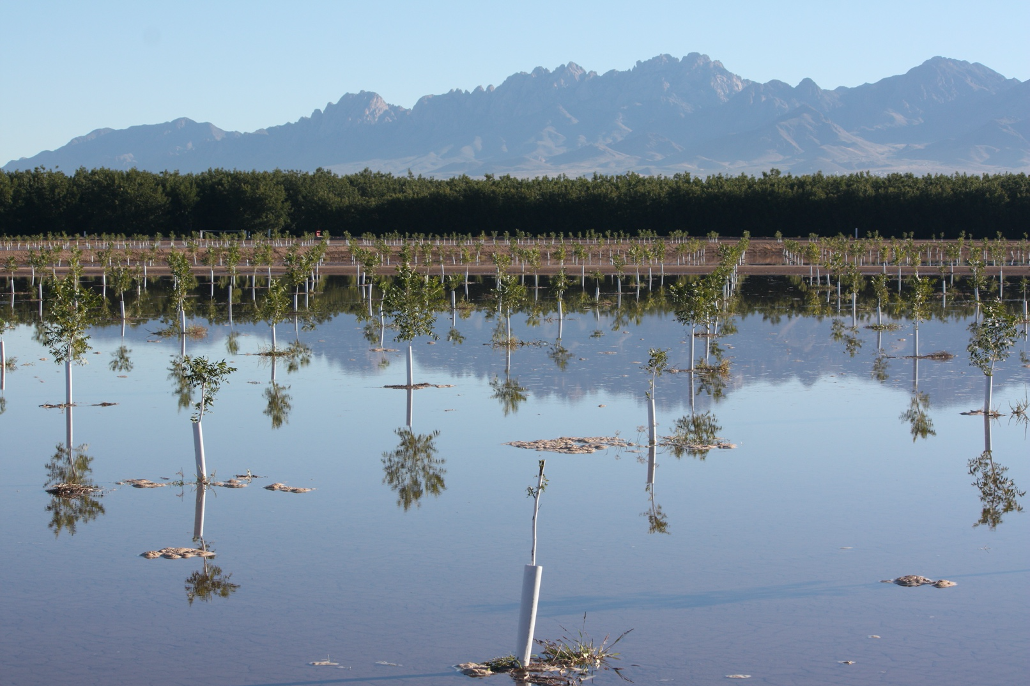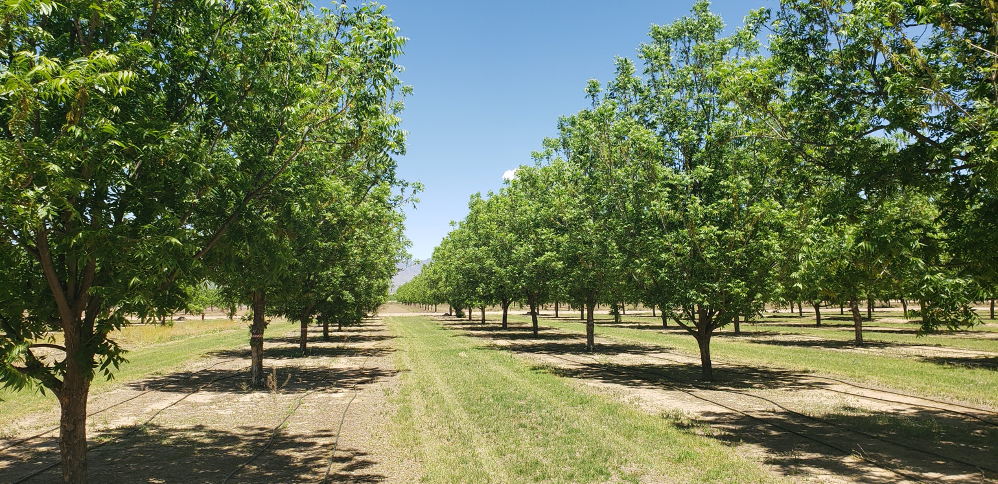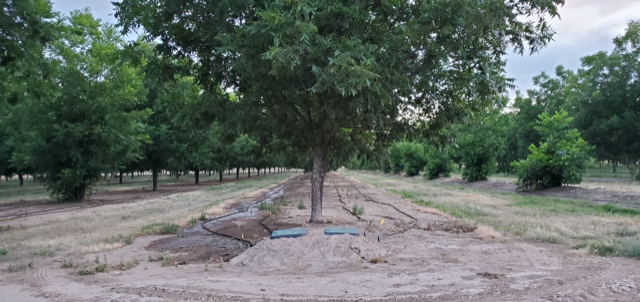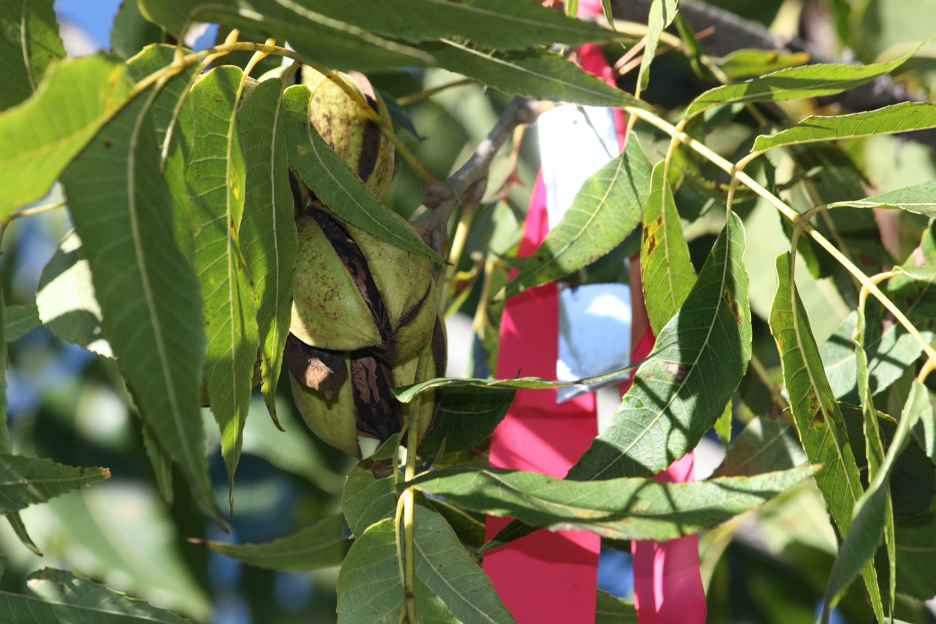
Pecan production in southern New Mexico is growing. Every year, additional acres of new trees can be spotted around Doña Ana County. According to the USDA, New Mexico produces approximately 35% of the total U.S. pecan production, and roughly 70% of that comes from Doña Ana. No other single county in the U.S. produces more pecans.
It is an economic engine for the state. Relatively poor when compared to other states, New Mexico relies on its agricultural cash receipts. Pecans contributed more than $170 million to state coffers in 2018. With oil prices currently very low (New Mexico also benefits strongly from its fossil fuels,) the economic impact of pecan production on the region is difficult to exaggerate.
But southern New Mexico is semi-arid. Annual precipitation at New Mexico State’s Leyendecker Plant Science Research Center was 7.7 inches in 2018 and a mere 5.7 inches in 2019, approximately 15% of the annual evapotranspiration (ET) needs of pecan trees in the area. These differences in water needs are, of course, satisfied with regular surface and groundwater irrigations.
In a region where pressures on water supplies are all too real, it surprises some that basin (flood) irrigation remains the most widely used method of irrigating pecan orchards. Community acequias are a vital component of local agriculture and have been for many hundreds of years. As surface waters have become less dependable, however, producers have had to pivot more to groundwater supplies for their surface irrigations. This has led some to revisit drip and the benefits it can afford.

Better Control with Drip Irrigation
In a basin irrigated orchard, the producer has little control over their water. Apart from the crop being produced, weeds and other vegetation are supported in their competition, ultimately resulting in the need for additional water and pesticides for both unwanted vegetation and the insects they harbor. Orchard floor vegetation can lead to overall increased orchard transpiration, and pesticides need to be moved through the soil.
One of the primary arguments for flood irrigation in the region is the flushing of salts out of the root-zone. Salinity buildup in soils is a genuine challenge for producers worldwide and is not particular to any single irrigation method. Surface irrigation can indeed be very effective at moving salts further down the soil profile. Of course, it assumes that the water source is low in salts. Unfortunately, in south-central New Mexico, this is decreasingly true. Surface water sources can carry the salts leached from upstream production, and heavily utilized subsurface water can carry high total dissolved solids (TDS) loads when brought from the lower depths of many of the new, deeper wells being drilled.
Add to this the oft-used practice of stopping the flow of water onto a field once it has moved across the orchard and reached the far end, or “foot” of the field, and salt buildup can still easily become an issue for producers using basin irrigation. Under this practice, water flows to the “head” of the field for the entirety of the irrigation, but onto the foot for a relatively short time. The result on a typical level field is a sub-surface gradient of infiltrated water where the wetting front “pinches out” near the foot of the field. This is likely to result in less water being available to those trees, but this wetting front is also the accumulation zone for leached salts. Over time, this can leave high concentrations within the effective root depth of trees located farthest from the irrigation points, inhibiting their production and threatening their long-term viability. Back at the head of the field, depending on the length of the irrigation, water may infiltrate well past the effective root depth of orchard trees, an additional, and avoidable, loss of water resources.
Drip and other micro-irrigation methods afford a much higher level of control to the producer, and far less opportunity for losses through runoff, deep percolation and evaporation. Water is applied directly where it is needed, supporting the crop and little else. Transpiration from orchard floor vegetation and other weeds is reduced, as is evaporation and the introduction of salts into the soil. Fertilizers and other inputs can be combined with irrigation waters prior to application, reducing application costs. Leaching fractions can be used to maintain a wetting front below the plant’s root-zone.

Deficit Irrigation in Pecans
The effects of targeting irrigations have the potential to go beyond these frequently referenced benefits. Deficits can also be targeted to encourage several possible and beneficial responses. Whereas simple deficit irrigation generally refers to the practice of applying irrigation water in amounts less than the orchard ET, regulated deficit irrigation, or RDI, involves specific deficits aimed either temporally or spatially to provoke a particularly positive response or mitigate a negative one. Two possible examples of this recently studied by our team at NMSU were growth-stage based deficit irrigation (GSDI) and partial root-zone drying (PRD) regimes on Pawnee pecan trees.
For our GSDI study, we had a 25% reduction in water, compared to the fully irrigated control, applied during the initial growth stage. For pecan, this can be generally defined as running from the start of irrigation in spring until roughly the beginning of July when the “water-stage” or kernel filling, gets underway in the pecan fruits.
With water availability being the driving developmental force behind the water-stage, deficits there are ill-advised. So too, when the nuts are out of the water-stage and hardening, as deficits there may have an impact on the return bloom in the following season (a topic for another article on its own). By applying the deficit in the initial growth stage, we are able to focus valuable water resources on the growth stages where they have the most impact on the successful production of nuts over excess vegetative growth.

Partial Root-Zone Drying
Partial root-zone drying goes a bit further. In a PRD regime, water is applied to only one side of a tree row for approximately four weeks before alternating back to the other side. This approach provides the same amount of water to the trees, but by leaving roughly half the root-zone in drying soil, a drought response may be stimulated in the tree where transpiration is reduced via a physiological response in the canopy. When the sides are alternated and the previously dry soil is watered again, affected roots may experience a flush of growth, leading to larger masses of young roots better suited to uptake water and nutrients than may otherwise occur. Meanwhile, the previously watered side begins its dry-down cycle, maintaining the physiological response.
PRD has been widely used in grape production throughout the world with many positive effects and has produced similar results in other crops. Improved water use efficiency (WUE), increased yields, and higher quality factors have all been reported in association with the practice. However, in our study, the more favorable initial returns have been with GSDI. Over two seasons, both the average nut weight and overall yield were higher than those under partial root-zone drying alone, with the average nut weight exceeding that of our control for both seasons, with total yield only slightly less than the control. Physiological performance of the GSDI trees also tracked very closely with those in the control group, indicating little to no apparent stress response to the deficit, all excellent indicators of long-term viability.
At the time of this writing, we continue to analyze both root growth and return bloom data relating to the two approaches and will be able to report on those results soon. Still, for producers wanting to maximize their water resources, and perhaps exercise greater control over their tree’s development, the time may be right to reconsider drip for pecans.
This material is based upon work that is supported by the National Institute of Food and Agriculture, U.S. Department of Agriculture, under award number 2015-68007-23130.










